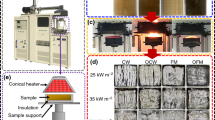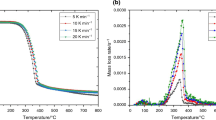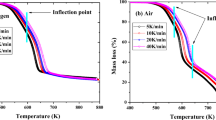Abstract
Piloted ignition of woods has been commonly investigated, which is accelerated by a spark plug. Autoignition is a complex phenomenon that combustible materials are ignited by internal heating, without the spark plug. Compared with piloted ignition, process of autoignition is closer to the development of real fire. Very few studies have focused on the prediction of ignition time and average mass loss rate by autoignition. Therefore, ignition time and mass loss rate on six species of commonly used wood samples, namely pine, beech, cherry, oak, maple, and ash, were studied under external heat flux by autoignition in a cone calorimeter. Three mass loss stages of woods under external heat flux was observed. Empirical models of ignition time and average mass loss rate for woods under external heat flux were developed. These empirical models can be used not only for fire risk evaluation, but also for modeling input and validation.






Similar content being viewed by others
References
Li XR, Koseki H, Momota M. Evaluation of danger from fermentation-induced autoignition of wood chips. J Hazard Mater. 2006;135:15–20.
Delichatsios MA, Panagiotou TH, Kiley F. The use of time to ignition data for characterizing the thermal inertia and the minimum (critical) heat flux for ignition or pyrolysis. Combust Flame. 1991;84:323–32.
Blijderveen MV, Gucho EM, Bramer EA, Brem G. Autoignition of wood, char and RDF in a lab scale packed bed. Fuel. 2010;89:2393–404.
Wang YF, Yang LZ, Zhou XD, Dai JK, Zhou YP, Deng ZH. Experiment study of the altitude effects on autoignition characteristics of wood. Fuel. 2010;89:1029–34.
Liodakis S, Bakirtzis D, Lois E. TG and autoignition studies on forest fuels. J Therm Anal Calorim. 2002;69:519–28.
Mitchell P. Methods of moisture content measurement in the lumber and furniture industries. www.ces.ncsu.edu/ (2011). Accessed 7 Mar 2012.
Fire Testing Technology Limited. User’s guide for the cone calorimeter. West Sussex: Fire Testing Technology Limited; 2001.
Kim JY, Lee JH, Kim SM. Estimating the fire behavior of wood flooring using a cone calorimeter. J Therm Anal Calorim. 2011;. doi:10.1007/s10973-011-1902-1.
Xu Q, Griffin GJ, Jiang Y, Preston C, Bicknell AD, Bradbury GP, et al. Study of burning behavior of small scale wood crib with cone calorimeter. J Therm Anal Calorim. 2008;91:787–90.
Nie SB, Liu XL, Wu K, Dai GL, Hu Y. Intumescent flame retardation of polypropylene/bamboo fiber semi-biocomposites. J Therm Anal Calorim. 2012;. doi:10.1007/s10973-012-2422-3.
Janssens M, Douglas B. Wood and wood products. In: Harper CA, editor. Handbook of building materials for fire protection. New York: McGraw-Hill; 2004. p. 7.1–7.58.
Cachim PB, Franssen JM. Comparison between the charring rate model and the conductive model of Eurocode 5. Fire Mater. 2009;33:129–43.
Quintiere JG. A semi-quantitative model for the burning rate of solid materials. NISTIR 4840. Gaithersburg: National Institute of Standard Technology (NIST); 1992.
A. Atreya, M. Abu-Zaid, Effect of environmental variables on piloted ignition. The 3rd international symposium on fire safety science, University of Edinburgh, Scotland, 8–12 July 1991.
Mikkola E, Wichman IS. On the thermal ignition of combustible materials. Fire Mater. 1989;14:87–96.
Carslaw HS, Jaeger JC. Conduction of heat in solids. Oxford: The Clarendon Press; 1959.
M. Janssens, Fundamental thermo physical characteristics of wood and their role in enclosure fire growth. PhD Thesis, University of Gent, Belgium, 1991.
Harada T. Time to ignition, heat release rate and fire endurance time of wood in cone calorimeter test. Fire Mater. 2001;25:161–7.
Babrauskas V. Ignition handbook: principles and applications to fire safety engineering, fire investigation, risk management and forensic science. Issaquah: Fire Science Publishers; 2003.
Babrauskas V. Ignition of wood: a review of the state of the art. The ninth Interflam, Edinburgh. Scotland: Interscience Communications; 2001.
Babrauskas V, Parker WJ. Ignitability measurements with the cone calorimeter. Fire Mater. 1987;11:31–43.
Wesson HR, Welker JR, Sliepcevich CM. The piloted ignition of wood by thermal radiation. Combust Flame. 1971;16:303–10.
Mehaffey J. Fire dynamics I: ignition and burning of solids, Lecture notes. Ottawa: Carleton University; 2002.
W. Simpson, A. TenWolde, Physical properties and moisture relations of wood. In: Wood handbook—wood as an engineering material, Forest Products Laboratory, Madison 1999, pp 3.1–3.24.
The Engineering ToolBox. Solids—Specific heats. www.engineeringtoolbox.com/ 2011. Accessed 7 Mar 2012.
VanderGheynst JS, Walker LP, Parlange JY. Energy transport in a high-solids aerobic degradation process: mathematical modeling and analysis. Biotechnol Prog. 1997;13:238–48.
Hrcka R. Variation of thermal properties of beech wood in the radial direction with moisture content and density. The 6th international symposium wood structure and properties, Arbora Publishers, Zvolen, 2010.
Zahirovic S, Scharler R, Obernberger I. Advanced CFD modeling of pulverised biomass combustion. International conference on science in thermal and chemical biomass conversion, Victoria, Canada, 2004.
Luo JW, Ying K, Bai J. Savitzky-Golay smoothing and differentiation filter for even number data. Signal Process. 2005;85:1429–34.
Branca C, Di Blasi C. Global kinetics of wood char devolatilization and combustion. Energy Fuels. 2003;17:1609–15.
Author information
Authors and Affiliations
Corresponding author
Rights and permissions
About this article
Cite this article
Shi, L., Chew, M.Y.L. Experimental study of woods under external heat flux by autoignition. J Therm Anal Calorim 111, 1399–1407 (2013). https://doi.org/10.1007/s10973-012-2489-x
Received:
Accepted:
Published:
Issue Date:
DOI: https://doi.org/10.1007/s10973-012-2489-x




